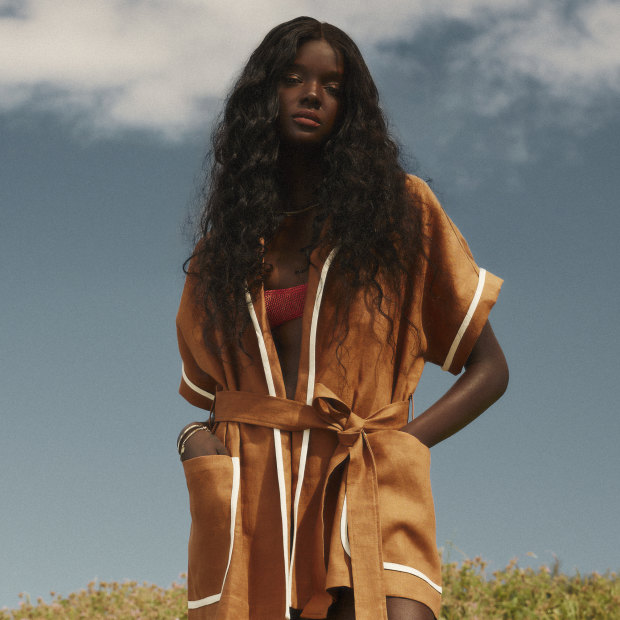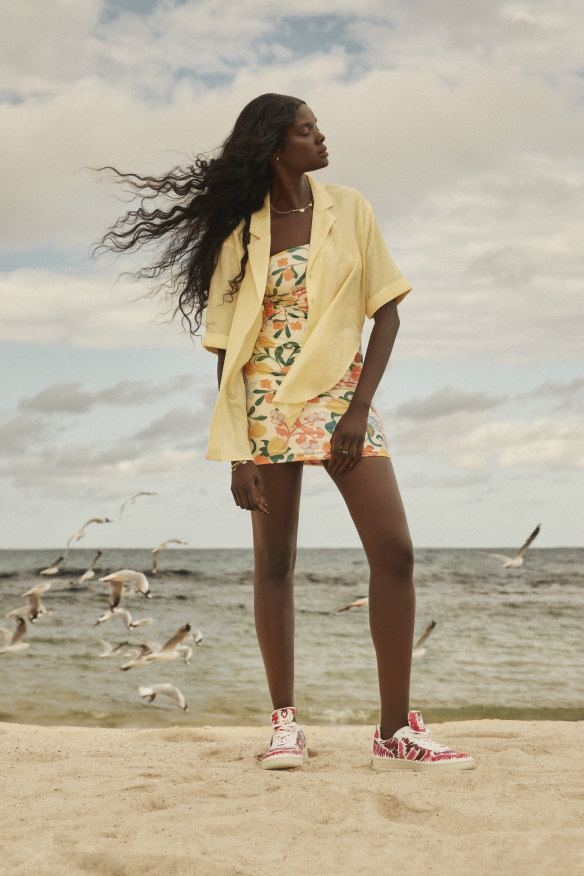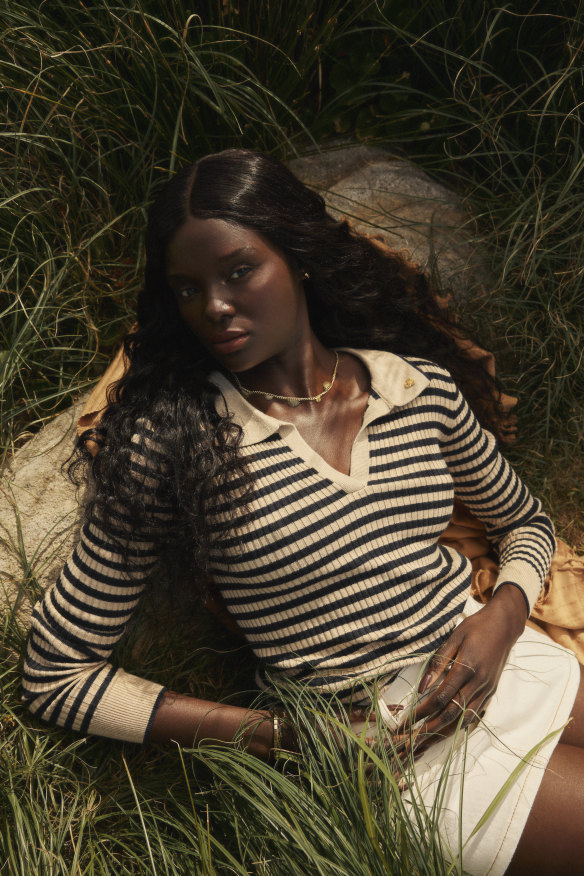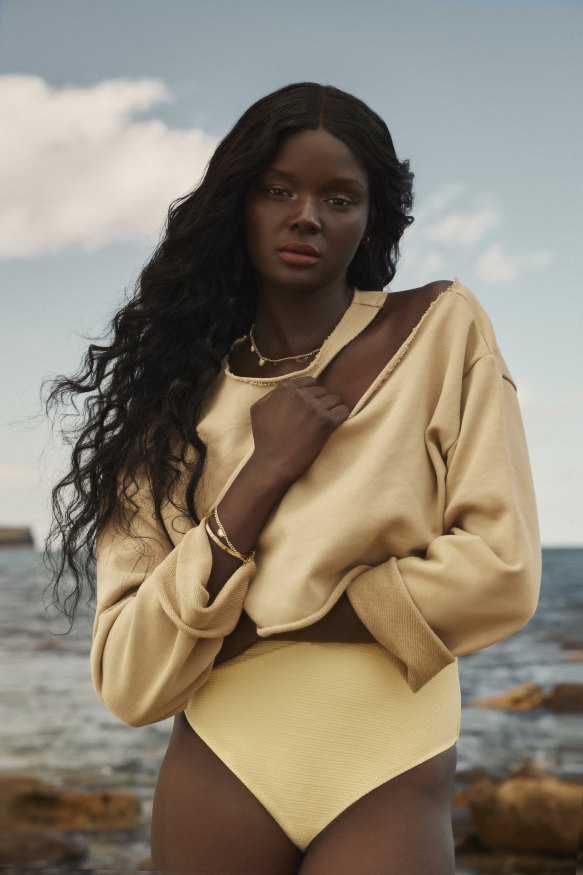This was published 1 year ago
Model Duckie Thot on racism, Rihanna and why her father is her greatest role model
She’s gone from struggling to find work to being one of the hottest models in the world. Duckie Thot opens up about resilience and having her moment to shine.
By Jane Rocca

Duckie wears Oroton robe, $449, Wanderlust + Co bangle, $232, and Chuchka “Sunset” necklace and bracelet set, $89, all from The Iconic. All jewellery worn throughout. Bond-eye “Lissio” bikini top, $110. Credit: Jedd Cooney
In 2013, at just 17 years of age, Duckie Thot, the Melbourne-born daughter of South Sudanese refugees, placed third on Australia’s Next Top Model. It should have been the launch of a glittering career, but instead she struggled to book a job.
In 2017, a trip to New York changed everything, with Kanye West – then
an aspiring designer yet to announce a bid for the US presidency or air his anti-Semitic views – the first to book her for his fashion line, Yeezy. This led to becoming the face of Rihanna’s Fenty Beauty. Back in Australia walking the runway for The Iconic, the 27-year-old caught up with Sunday Life for a chat.
Accompanying your sister Nikki on fashion shoots in Melbourne planted the seed that modelling could be your career, but when did it all begin to take shape? I loved going on jobs with Nikki, sitting in the background, taking it all in. She is five years older than me and I was 13 when I started going to give her support. I naturally fell in love with modelling and I auditioned for Australia’s Next Top Model at 16, then again at 17 and got on the show [she came third in the eighth season]. My career took off from there.
You come from a very close family. Is resilience part of your DNA because of this? I come from a large family. I’m the second youngest child and my mum was pregnant with me when fleeing the war in South Sudan in 1995. Growing up in Melbourne, I saw the family transition to a new way of life, adapt to a new country, and it wasn’t an easy situation. Resilience comes with seeing what our family went through, learning our family history and how it connects us.
Do you often wonder how things might have turned out if they didn’t migrate to Australia? I know things could have turned out differently for all of us. They left a bad war, but the chance to come to Australia meant they could embrace the culture here and have a new lease on life. Understanding my roots was important to my parents – I didn’t speak English until I went to school – but they were also of the view that you work hard to get out of a situation. They remind me that my identity is part of me but there is also another part, the Australian identity. And that being Australian means I can also make a life here, because this is home. My parents always pointed out that possibilities were mine to attain, too. I have a maternal grandmother back home I haven’t met yet. I speak to her all the time and hope to meet her soon.

Lover “Lara” shirt, $160, and “Limonata” dress, $240, from The Iconic. Veja x Marni “V-10 Marsala” sneakers, $410. Arms of Eve “Harper” ring, $69, from The Iconic.Credit: Jedd Cooney
What was school like for you? I went to multicultural schools and attended a private Christian high school with people from all backgrounds. I loved growing up in Melbourne. I know I didn’t look like everybody else, but it put me in a position to listen. I grew up in a very white Australia and that is okay. But I also knew that when I heard somebody say something that might be wrong, I took the road of least resistance. Sometimes I got an apology, and sometimes people realised they might have been wrong, but the world is like this and every black person knows it.
Has diversity in modelling improved since you debuted in 2013? The industry has changed so much in those years. You definitely see a lot more models cast from different backgrounds: black and Asian women and a whole mix of body types. It’s no longer the ordinary stereotype of what a model used to be. You aren’t going to be surprised when you don’t see a young slim model and I’m glad I’m part of that process of change for more black women represented, too.
How have you dealt with racism in the industry? I always want to be somebody who can see past it and I always want to be someone who does the work to be better and do better. Sometimes you hear someone say something out of turn or wrong in the industry, and later apologise. It’s okay to take that apology. Racism doesn’t have to be reactive – most people will realise it was wrong.
Who’s been your greatest supporter in the beauty industry? Working with make-up artist Pat McGrath was pivotal in what came next in my career. To have her fully embrace me and pitch me to top-line clients was massive. To have someone like her speak my name in other rooms led me to work with Rihanna.

Scotch & Soda polo shirt, $200. Camilla and Marc “Limia” skirt, $250, from The Iconic. Turkish Murkish “Stonewashed” towel, $90. Arms of Eve “Harper” ring, $69, from The Iconic.Credit: Jedd Cooney
What was it like to work with Rihanna for Fenty Beauty? It was a big moment; it led to being a global ambassador for L’Oréal for three years. I met Rihanna through mutual friends in New York, we hit it off, and I became the face of Fenty Beauty for darker skin shades. Rihanna challenged the beauty industry to expand their shades and being that face opened doors for me. She is an incredible woman. She works around the clock. I loved being on set and working with her; the hours were long but she was always there and working them as well.
Who is your greatest role model? It would be my dad, Latjor. He’s a man of few words, but when he does speak it’s always powerful. He reminds me to be humble and remember where we came from. To remember to go slow and really think through the things you want to do. He taught me to pace myself and have a clear vision, to dream big and keep going. Seeing him build his own career to become a veterinarian has been amazing. He sat exams and failed by a few points at times, but kept going back. It showed me if you really want something you can achieve it.
What was it like taking part in Supreme Models, a six-part documentary that focuses on the work of black models in fashion? To be given a platform to be united and share our experiences collectively made the process easier for me. It didn’t feel like we were going against the grain or speaking out alone. To be with models past and present and be vulnerable with our journeys was inspiring. To see Iman there and become friends with her away from the cameras felt authentic and real. It’s a support system that is genuine. The documentary is an adaptation of Marcellas Reynolds’ book. It’s a true labour of love and so important to be heard and tell our story.

C&M Camilla and Marc “Odiel Crew” sweater, $240, Aere swimsuit, $100.Credit: Jedd Cooney
How do you look after your mental health in the high-pressure world of fashion and modelling? I am a strong Christian and believer in God; I think people need to have a belief in higher powers and a higher self. And I’m always reading books and trying to get my thoughts out; it’s good for personal growth and I want to hone that. It’s how I keep myself grounded and learn more about myself; I want to go deeper, see what else I can tap into. It’s also important to have people who’ll tell you it’s okay to be vulnerable. That’s the key to being human.
Has your Christian faith always been a cornerstone of your life? It has always been part of my life. When I moved to New York I didn’t have the protection of my family and found myself alone. I realised I only had myself to fall back on. That grew my faith and pushed me to grow more over the last few years.
What are your plans and goals for the next five years? It’s amazing how much has happened in the last five years of my life. I hope to have established myself to do things outside of modelling, and hopefully to have a family of my own.
Make the most of your health, relationships, fitness and nutrition with our Live Well newsletter. Get it in your inbox every Monday.